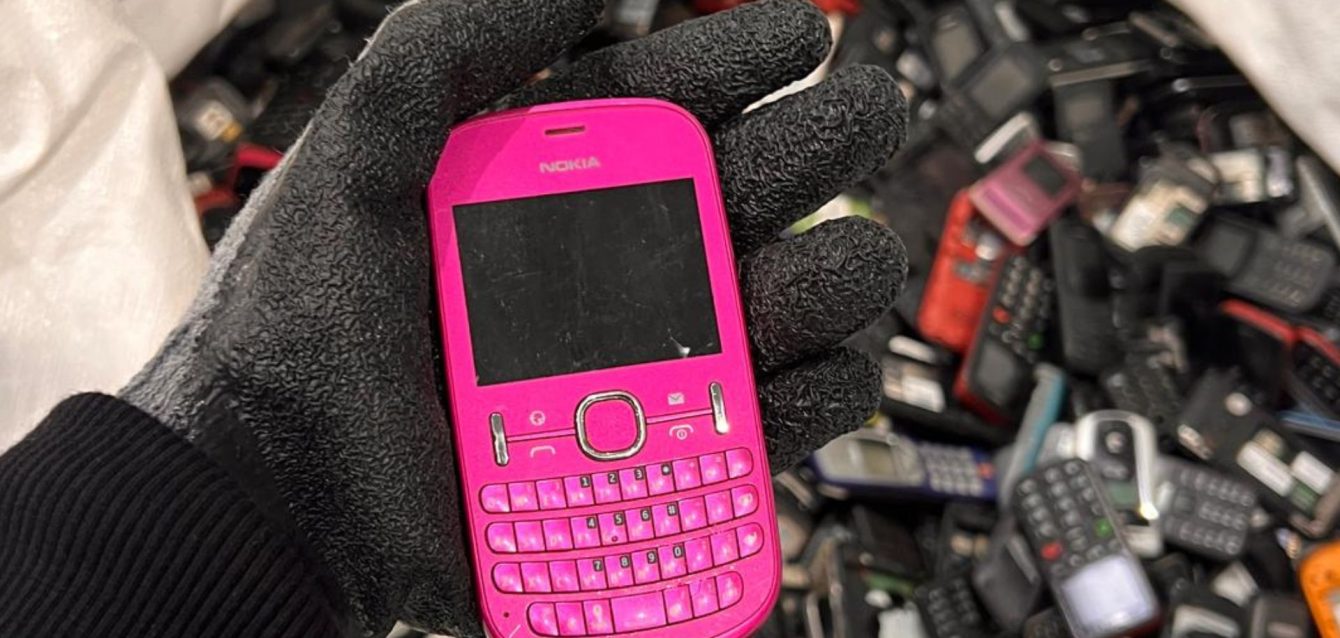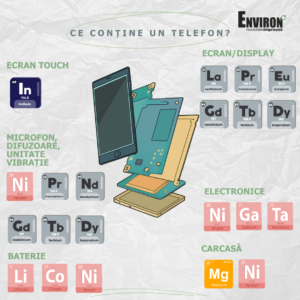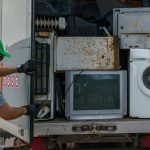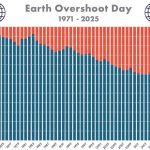Romania has the opportunity to recover 2 tons of rare metals annually only by recycling used electrical and electronic equipment, according to a statement from the Environ Association on the occasion of Earth Day.
The recovery of rare metals is one of the greatest global challenges, as these have become indispensable in recent years across a wide range of modern technologies and applications, due to their unique electronic, magnetic, and optical properties. As recently as mid-April, the European Parliament adopted a Regulation with clear provisions aimed at recycling electrical waste in order to ensure at least 25% of the EU’s annual consumption of strategic raw materials.
Reported to the quantity of waste electrical and electronic equipment that should be collected and recycled in Romania, calculations made by the Environ Association show that one ton of recycled mobile phones could generate 3.3 kg of rare metals annually. At the same time, two tons of monitors could generate 1.2 kg of rare metals, and one ton of fluorescent lamps could yield 1 kg of rare metals. In total, through WEEE recycling, Romania could recover two tons of rare metals annually.
“Electronic waste, which contains almost the entire periodic table of elements, has significant potential to become an alternative source of rare metals, while also reducing dependence on primary mining and its associated environmental impact. At the same time, smart recycling would contribute to the circular economy by minimizing waste disposal, conserving natural resources, and promoting sustainable development,” said Roxana Puia, Communications Director of the ENVIRON Association.
Which rare metals are found in electronic equipment
The most important amounts of rare metals are found in electrical and electronic equipment such as fluorescent lamps, computers, mobile phones, televisions, and video cameras. While hard drives and fluorescent lamps contain the highest concentrations of rare metals, especially neodymium (Nd), dysprosium (Dy), yttrium (Y), and europium (Eu), smartphones and computers contain the widest variety of rare metals.
FLUORESCENT LAMPS use phosphors rich in yttrium and europium, which makes them the electronic waste with the highest concentration of rare metals, up to 20,000 ppm (parts per million), i.e. 2%. In addition to yttrium and europium, significant amounts of cerium, terbium, and lanthanum can also be extracted.
HDD Any hard disk contains NdFeB magnets, which are a main source of neodymium and dysprosium, reaching concentrations of up to 15,000 ppm, i.e. 1.5%. Alongside these rare metals, an HDD also contains an important amount of praseodymium.
SMARTPHONES Smartphones often contain, in their magnets, significant amounts of dysprosium, terbium, and neodymium, in concentrations up to 1,000 ppm (0.1%). Also, in screens, speakers, or vibration systems, there are lanthanum, cerium, praseodymium, samarium, europium, gadolinium, and yttrium, making recycled smartphones the electronic equipment with the greatest variety of rare metals among common WEEE.
COMPUTERS From printed circuit boards, hard drives, and speakers found in a computer, the same categories of rare metals as in mobile phones can be extracted: lanthanum, cerium, praseodymium, neodymium, samarium, europium, gadolinium, terbium, dysprosium, and yttrium, in proportions of 1,000 ppm (0.1%).
TELEVISIONS use significant amounts of rare metals in their display components, such as phosphors in cathode tubes and LEDs in modern screens. We also find here a wide variety of rare metals, such as yttrium, europium, and terbium, reaching concentrations of up to 100 ppm, i.e. 0.01%.
VIDEO CAMERAS. Another category of electronic waste rich in rare metals are video cameras, whose screens and speakers contain yttrium, europium, and terbium in proportions up to 100 ppm, i.e. 0.01%.
Rare materials around the globe. Where does Romania stand
Rare earths include a list of 17 chemical elements that, in recent decades, have become increasingly sought after due to their use in many advanced technologies: Scandium (Sc), Yttrium (Y), Lanthanum (La), Cerium (Ce), Praseodymium (Pr), Neodymium (Nd), Promethium (Pm), Samarium (Sm), Europium (Eu), Gadolinium (Gd), Terbium (Tb), Dysprosium (Dy), Holmium (Ho), Erbium (Er), Thulium (Tm), Ytterbium (Yb), and Lutetium (Lu).
According to a recent report by the United States Geological Survey (USGS), the global rare earth market is dominated by China, with reserves of 44 million tons, followed by Brazil (21 million tons), India (6.9 million tons), Australia (5.7 million tons), Russia (3.8 million tons), Vietnam (3.5 million tons), the USA (1.9 million tons), Greenland (1.5 million tons), and Tanzania and South Africa (900,000 tons each).
Although there is no official public estimate of Romania’s total rare metal reserves, we have an order of magnitude: two years ago, our country imported 557 kilograms of scandium and yttrium.
At the same time, Romania has been included in the list of the European Union’s strategic projects for the extraction of critical raw materials, as it holds significant geological resources of manganese (18 million tons of ore distributed across several important deposits), magnesium, graphite, and copper.
Recycling electrical waste containing rare metals in the EU
When it comes to recycling electrical waste containing rare metals, at the European Union level there is major concern: last year, the European Parliament adopted the Regulation (EU) 2024/1252 of the EP and the Council, which provides, among other things, that each Member State must adopt and implement, within two years, national programs to ensure the secure and sustainable supply of critical raw materials. One of the stated goals is for the European Union to increase its recycling capacity so as to produce at least 25% of its annual consumption of strategic raw materials.
The regulation provides for intensifying the collection, sorting, and processing of waste with relevant potential for the recovery of critical raw materials and introducing them into the appropriate recycling system. Special attention is given to products containing one or more permanent magnets; these products must be labeled to indicate the content of strategic metals, including rare metals such as samarium (Sm) or neodymium (Nd). The regulation also identifies 34 critical raw materials, including 17 strategic raw materials, among them rare earths for permanent magnets (Nd, Pr, Tb, Dy, Gd, Sm, and Ce).
Currently, only 1% of the demand for rare metals is met through recycling of electrical waste. With the exception of lithium (Li) and germanium (Ge), many critical raw materials – especially rare earths – are difficult to recover from electronic waste.





